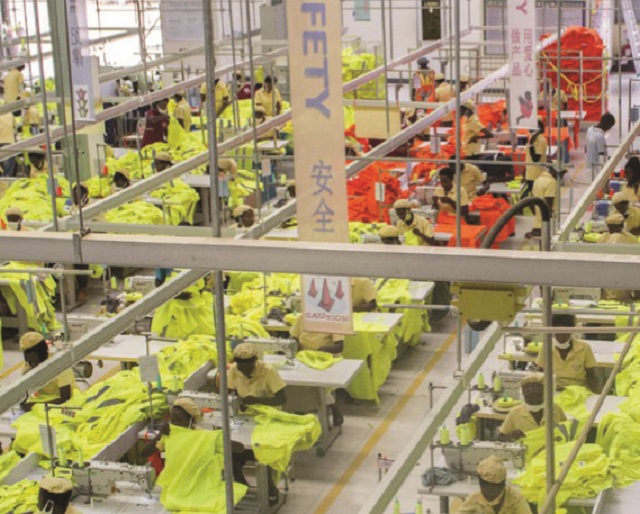
Critics say banning second hand clothing won’t necessarily boost local industry. And operations like Ma’s won’t be enough to replace chagua; most of the C&H products are for export. Others say that used clothes will likely be smuggled in. Higher taxes on imports of second-hand shoes, introduced recently, have so far failed to seriously dent business, according to traders.
Marc Vooges, director of Sympany, a Dutch charity that recycles used clothing, says the ban also limits citizens’ rights to make their own decisions. “You disrespect the choice of your citizens who are choosing those second hand clothes instead of new clothes which are available for them. There must be a reason for that. Respect that reason,” he says.
Made in Africa, with China
Other African countries have already attracted Chinese textile makers. Chinese shoe assembly operations in Ethiopia have inspired more industry around it like leather processing, recycling old plastic bags into plastic goods, as well as more shoe factories from other countries. Huajian, one of China’s largest shoe producers, is expanding in Ethiopia and in East Africa. Other Chinese investors have expressed interest in setting up shop in an industrial park in Tanzania, turning local cotton into cloth.
Shoes and clothing may be just the beginning. As labor costs in China have risen over the last decade, prompting Chinese factories to seek cheaper locations or move into higher-end manufacturing, African officials have hoped some of that manufacturing might relocate to Africa. Lately, Chinese officials have been dangling that prospect even more.
At a high level China-Africa summit, the Forum on China-Africa Cooperation, in Johannesburg late in 2015, China’s ambassador to South Africa Tian Xuejun told a press briefing, “We want to change the narrative from ‘made in China’ to ‘made in Africa, with China.’” In one of conference sessions titled, “Catapulting the African industrialisation renaissance,” Chinese officials pledged to help the continent reach its goal of seeing manufacturing account for more than 50% of GDP by 2063.
For now, industry accounts for just 10% of Africa’s overall GDP, the same rate as it was in 1990, according to John Page, a Brookings Institution fellow and former chief Africa economist for the World Bank. As China moves out of low-end manufacturing, there may now be a chance for Africa to gain some of that business. “There is a window of opportunity,” Page says.
Chinese investment in African manufacturing has already grown, and examples of Chinese factories producing in Africa are becoming more common. In Kigali’s special economic zone, another Chinese company, Beijing Paper, produces sanitary napkins under the brand “Every Time,” sold in stores locally. A nearby Chinese company makes wooden doors. Ma is considering reopening the mobile phone factory she attempted in Kenya five years ago. China FAW Group, one of China’s biggest auto makers, now has an assembly plant in South Africa.
In some cases, Chinese investment in African textile industries has actually hurt local producers. In Ghana, Chinese manufacturers are out-competing artisans and putting them out of business. This past year, Nigerians have been protesting Chinese who are manufacturing their traditional fabrics and selling them at cheaper prices.
Some initiatives to inspire manufacturing have been underwhelming. At the workshop of the “China Rwanda Bamboo Project” in Kigali—a Chinese initiative to train local workers in bamboo manufacturing—three young men and a woman nap on a piece of foam meant to be used for furniture. The room is littered with unfinished bamboo screens, baskets, and lanterns. The power is out so the staff have stopped early.
“They don’t work. You teach them one thing, they learn it, and the next day they come back and they’ve forgotten,” says Huang Daizhong from China’s Zhejiang province, who has been leading this project for the past six years. The results have been meager. So far, just two factories are making use of the bamboo processing techniques he has taught them—both are making toothpicks.
In Huang’s home province of Zhejiang in eastern China, mass production of bamboo handcrafts was the first step in establishing a textile industry and training a largely rural population with few technical skills. (Textile producers now account for 10% of that province’s gross industrial output.) Huang had hoped the same principle would work in Rwanda, but has been disappointed.
“Rwanda hasn’t reached this point of being able to manufacture yet. It will still take many years,” he says.
For a country’s civilization
Rwanda isn’t the easiest place to start a garment industry. Transportation to the land-locked country is expensive—it costs more to send a container from Kigali to Kenya’s port city of Mombasa, where all of C&H products depart from, than to send goods from Mombasa to Guangzhou in southern China. Ma has to import all of her materials, including the cloth, string, and the zippers.
Still, Ma, who has been working in textiles in developing countries for more than 16 years, believes she is uniquely equipped to meet the challenge. Unlike Huang and other Chinese managers who grow frustrated with their local staff, she says she tries to understand her employees and how they work best. “You just have to know them,” she says.
The company is not yet profitable, but she expects this year to be better. Ma anticipates more Chinese production moving to Africa as Southeast Asia becomes saturated with Chinese factories searching for cheaper locations. She will still have been the first in Rwanda.
And perhaps most importantly, she relates with the government’s campaign to wean the country from chagua.
”In China during the 1980s there were also a lot of people wearing old, second-hand clothing. Now, not a single person is wearing recycled clothing. I think that for a country’s civilization to progress you do need to stop that.”
This story is part of a series about China’s engagement in Rwanda and reporting was supported by the International Women’s Media Foundation’s African Great Lakes Initiative.
****
 The Independent Uganda: You get the Truth we Pay the Price
The Independent Uganda: You get the Truth we Pay the Price



There are a huge number of poor people that rely on second hand clothes as they cannot afford new clothes. That’s why I don’t think this should be banned in any country.